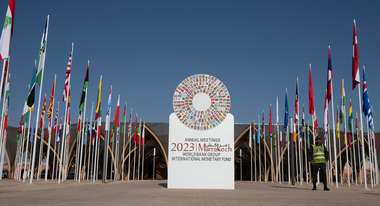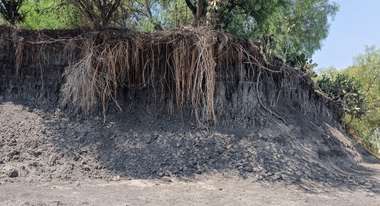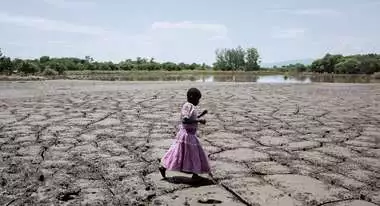New start for Cotonou Agreement: What future for the past?
Although the EU has now concluded numerous bilateral and regional trade agreements, the framework with African, Caribbean and Pacific countries is now to be signed after bumpy negotiations.

Ready to sign?
On the 27th of April 2023, the BMZ published a press release announcing that the federal cabinet had approved the signing of an international agreement between the EU, its 27 member states, and the 79 members of the Organisation of African, Caribbean and Pacific States (OACPS). The latter group includes many small island developing states, including the Maldives as its most recent member, as well as large Sub-Saharan African States such as populous Nigeria. Its membership also covers the full scale from Least-Developed States to High-Income Countries, some of which with higher GDP per capita levels than some EU member states.
The international agreement was originally foreseen to enter into force on the 1st of March 2020, replacing the existing Cotonou agreement that was signed twenty years earlier. A combination of factors however delayed the conclusion of the negotiations of what is commonly referred to as the “Post-Cotonou Agreement”. Negotiations were concluded in December 2020, while April 2021 saw a formal conclusion through the initialling of the agreement, i.e. both chief negotiators mutually signing off on the final version of the text. At this point, the next step should be the signing and subsequent ratification of the agreement. The signing ceremony normally takes place at the location after which the agreement will be named, with the OACPS already having chosen their Pacific member Samoa. Yet instead of this, a long delay followed and has so-far required the EU and OACPS to agree on three further extensions of the existing Cotonou agreement, so as to avoid a so-called ‘legal gap’. At the time of writing this article – the end of May and a full month since the German federal cabinet’s decision – the EU’s member states are yet to reach consensus on signing the agreement.
Before looking at this current situation and what might (not) happen next, let us zoom out and look at the history of this partnership and the objectives it pursues.
The ACP-EU Partnership: the past
When the Rome Treaty that created the European Economic Community (EEC) was signed in 1957, two of the six founding members states still had colonies in Africa. Already in 1950, French foreign minister Robert Schuman called for making the development of the African continent an essential task of the European integration project. During the Rome Treaty negotiations, France accordingly pushed for including its “overseas countries and territories” (OCTs) into the Rome Treaty. The other founding members – including West-Germany – agreed so as not to jeopardise the European project and supported the creation of a separate intergovernmental fund to support the OCTs, the European Development Fund (EDF).
Not long after the ink of the Rome Treaty had dried, the big wave of African independence commenced. The nascent EEC sought to adjust to this new reality by continuing economic cooperation with their former colonies in Sub-Saharan Africa, which led to negotiations and the adoption of the Yaoundé Convention in 1963. This international agreement provided the basis for special trade preferences between the African states concerned and the EEC member states, with development cooperation as well as dialogue processes through various consultative structures continuing to funded through the EDF. In effect, the eighteen ‘associated’ African states received a better trade and aid deal from Europe than other developing countries.
A decade later in 1973, the United Kingdom, Ireland and Denmark joined the EEC. Their accession treaty included an invitation to a selected group of Commonwealth members to negotiate a new association agreement a new convention to succeed the second Yaoundé Convention, “side by side” with the current African states that were party to this agreement. Europe’s negotiations with the 46 African, Caribbean and Pacific (ACP) states concerned resulted in the 1975 Lomé Convention, signed in the capital of Togo, and the subsequent creation of the ACP Group and its permanent secretariat in Brussels through the Georgetown agreement that was signed later that year. The EU-ACP agreement was widely regarded as unprecedented in scope and ambition, and in addition to its non-reciprocal trade preferences and EDF financed cooperation featured ‘joint institutions’ for structured policy and political dialogue.
The Lomé Convention was renegotiated four times over the next quarter of a century, during which it went through key reforms and evolutions, as well as growing membership on both sides. Yet by the mid-1990s considerable fatigue frustration had set into the partnership: despite the asymmetrical trade preferences and substantial levels of European aid, results had been disappointing and many ACP states seemed not to have benefited from these favourable conditions in terms of economic growth and development. There was also little evidence of increased and effective cooperation as a result of the Conventions, neither between the EU and the ACP nor within the group itself. Last but not least, the creation of the World Trade Organisation and its dispute settlement system in 1995 created the basis for members to challenge Europe’s trade discrimination between countries of similar GDP levels that the Lomé Conventions promoted.
The sceptical atmosphere and calls for reform were the precursor to the negotiations of the Cotonou Agreement during the final years of the 1990s. The agreement as signed sought to fundamentally reform the EU-ACP relationship, including by promoting a more performance-based allocation of EDF funding, an enhanced political dialogue and a greater focus on regional integration processes within Africa, the Caribbean and the Pacific. The most important reform was the planned discontinuation of the non-reciprocal trade preferences granted under the agreement. This system was to be replaced by the EU’s General System of Preferences, that granted duty and quota-free trade to Least-Developed Countries under its ‘Everything but Arms’ scheme, as well as by negotiated trade agreements between the EU and regional groups of ACP states. The latter agreements are known as the Economic Partnership Agreements (EPAs) and are the most controversial feature of the Cotonou agreement.
The preparation
During and after the contentious EPA negotiations during the first two decades of the new millennium, the EU-ACP partnership itself gradually faded to the background: the 12 new member states that joined the EU after 2004 all had to accede to the Cotonou agreement, yet had not been involved in negotiating the agreement with them. Parallel to the partnership, the EU sought to deepen relations and cooperation with the African Union with whom it organised regular summits at the level of heads of state and government. Another noteworthy step concerned the removal of the reference to the ACP Group in the EU treaties, once the Lisbon Treaty entered into force in December 2009.
Following the limited engagement with the ACP during the Barroso II Commission, in 2014 the new Commission President Jean-Claude Juncker mandated his Commissioner for International Cooperation and Development to “preparing and launching negotiations for a revised Cotonou agreement”. This wording signalled the Commission’s preference for continuity in relations, with earlier statements highlighted the potential of the partnership for joint engagement – with EU speeches typically referring to a “majority in the United Nations” – despite limited evidence of EU and ACP structures being effectively used for this purpose. Contrary to the EU’s measured enthusiasm, the views of the member states diverged on the matter.
Three years of consultation, dialogue and evaluation followed, a period during which the United Kingdom – as a key factor influencing the very creation of the partnership – decided to leave the EU. By the end of 2016, the Commission proposed a compromise between those member states favouring continuity and those calling for fundamental change. This compromise proposed a hybrid new agreement consisting of a common foundation advancing a “political partnership”, and three regional pillars for cooperation with the states in Africa, the Caribbean and the Pacific. The diverging views reflected in this uneasy compromise, and wider intra-European challenges led to considerable delays to the adoption of the EU’s negotiation position, which was concluded in June 2018 – leaving less than two years to negotiate before the planned expiration of the Cotonou Agreement in February 2020. Yet the Commission’s proposed compromise was largely accepted by the EU member states, with one important change being the change from an indefinite agreement to one limited to twenty years with a possibility of extension.
By comparison, the ACP’s negotiation position was more straightforward and conservative. It decided to negotiate together as a block of states to preserve the status quo and key features of the Cotonou agreement, including a self-standing finance mechanism in the form of the EDF or a similar EU financing instrument dedicated to the ACP. A complication on the ACP’s side was the initial decision by the African Union in March 2018 to negotiate a cooperation framework between the EU that was separate from the ACP-EU framework. Lack of consensus within the AU however later that year resulted in the decision to allow for the AU-EU and ACP-EU partnerships to continue to exist in in parallel.
Negotiations were formally launched in the margins of the UN General Assembly in September 2018 by the two chief-negotiators: EU Commissioner Mimica who in December 2019 was succeeded by Jutta Urpilainen and Togolese Foreign Minister Robert Dussey. Before the end of the year, the ACP side agreed with the EU’s proposed approach to negotiate a common foundation and the three regional partnerships.

The negotiation
The negotiations failed to make much progress in 2019, mainly because of the EU leadership changes following the June 2019 European Parliament elections and the EU’s ongoing internal negotiations on its next budget framework for the period 2021-2027. The latter featured the proposal to incorporate the EDF into the budget, in the form of a single instrument for the EU’s external action covering cooperation with all parts of the world – the opposite of what the ACP were advocating for.
With the EU budget negotiations continuing at their usual slow pace, the advent of the global COVID-19 pandemic brought rapid and unprecedented changes to the negotiation process. Online videoconferencing tools were available to continue negotiating despite lockdowns and travel bans, tools which obviously had not previously been used to negotiate large international agreements. As negotiations progressed under these new conditions, a marathon European Council meeting in July 2020 resulted in a political agreement on the EU budget, including the incorporation of the EDF.
In parallel, negotiations progressed with the chief negotiators confronting key points of divergence in areas including migration, financing, as well as sexual and reproductive health and rights. During the final weeks of the German EU Council Presidency, a political deal on the new agreement was reached. This was followed by the finalisation and ‘initialling’ of the agreement in early 2021, paving the way to the agreement’s planned signature and ratification.
The limbo
Yet as we now find ourselves in the summer of 2023, the agreement is still not in force. Although the initialled agreement by and large reflects the design and preferences of the EU, it is the European side that has caused the delay. It is widely known though never confirmed by the European Council that Hungary was the cause for the absent consensus to commence with the signing in the period from April 2021 to April 2023. Since last month, Poland is reportedly blocking the EU’s decision.
In the meantime, the ACP witnessed important changes: in December 2019 the states endorsed the revised Georgetown Agreement. This agreement renamed the group to “Organisation of African, Caribbean and Pacific States” (OACPS) and set out ambitious objectives for its engagement beyond its relations with the EU and its member states. Yet few real changes in the organisation’s international profile were noticeable since the name change, and its influential member South-Africa – as well as important financial contributor to the group’s secretariat in Brussels – left the organisation in September 2021.
While Hungary and Poland are perhaps the prime causes of the new agreement’s delay and the several extensions of the Cotonou agreement, it also seems that the (non-)cooperation between the EU and the OACPS in recent years generated little sense of urgency and traction behind the new agreement. The world faces multiple crises, yet none seem to have mobilized a convincing and joint response by the EU and the OACPS, despite the international cooperation ambitions set out in the yet to be signed agreement. It is in part for this reason that during March few European heads of state seemed familiar with the agreement in the first place, while in February French President Macron made ambiguous comments at a press conference that saying that some frameworks are perhaps a bit worn out.
The future?
The current and likely final extension of the Cotonou agreement ends on the 30th of June. Since the new agreement provisionally enters into force two months after it is signed, the most optimistic scenario would see a short gap between the current and desired future agreement. This legal gap poses difficulties to the European Investment Bank, which uses the agreement with the ACP states as its license to operate and cannot enter into new operations in its absence. In addition, some meeting structures – especially the parliamentary exchange meetings between the EU and OACPS – may not be convened. Since development cooperation continues independently from the EU’s own budget and trade relations are now also arranged by the EU and through bilateral and regional trade agreements, the costs of the absence of an agreement are otherwise negligibly low.
It appears too late to completely do away with the framework, which if signed this year will be in force until at least 2044. Declaring the partnership a “political partnership” has proved not to be self-fulfilling, and based on the past decades of cooperation with similar structures and actors not a realistic one either. Hence what is needed is to clearly manage expectations and prioritise shared objectives among the many listed in the new agreement, and in parallel invest in functional alliances between Europe and (non-)ACP members worldwide to advance shared interests and realise global sustainable development.

Footnotes
(1) Editor's note: Hungary opposed the agreement for a long time because it was unhappy with the statements on migration, while Poland, according to media reports, will only agree if the EU decides that grain surpluses caused by imports from Ukraine, which harm Polish farmers, will be sent to Africa as food aid.
(2) The text of the initialed EU-OACPS agreement is available here: international-partnerships.ec.europa.eu/system/files/2021-04/negotiated-agreement-text-initialled-by-eu-oacps-chief-negotiators-20210415_en.pdf




